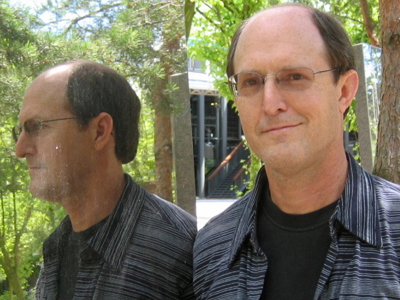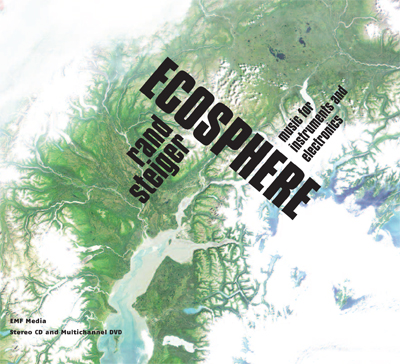Technology Institute at UC San Diego Names Composer in Residence
San Diego, July 6, 2010 -- Underscoring its interdisciplinary interest in computers and music, a technology research institute at the University of California, San Diego has appointed the outgoing chair of the university’s music department to be the institute’s second Composer in Residence.
|
Steiger is a professor of music at UC San Diego, where he has taught since 1987. He succeeds fellow music professor Roger Reynolds, who was Calit2’s inaugural Composer in Residence at UC San Diego. Reynolds will continue his affiliation with the institute.
"Roger Reynolds proved that there is much to be gained when Calit2 makes room for a creative artist who can work alongside computer scientists, electrical engineers and other technical staff,” said Ramesh Rao, director of the UCSD division of Calit2. "With Rand Steiger we hope to take that engagement to the next level. He has drawn inspiration from technology for his own compositions, and we anticipate that he will bring a fresh intellectual and cultural dimension to Calit2 while reaching out to other institute faculty, students and staff to collaborate on new technologies that can expand musical capabilities."
Steiger, age 53, says he plans to use his Calit2 residency to collaborate with the International Contemporary Ensemble on a series of compositions for all of the ensemble’s principal players. The collaboration, dubbed DigitICE, will involve a series of electro-acoustic works for solo instruments, and a large ensemble work. “We want to deploy innovative approaches to real-time digital signal processing,” said Steiger. “I am also interested in developing new approaches to publishing the compositions and recordings of the performances on the Internet and on DVD.”
|
Drawing inspiration from science is not usual for a composer, but Steiger has always looked at technology and science – and particularly the natural sciences – for stories and frameworks that he could explore and echo in his music. In 1989 the Los Angeles Philharmonic commissioned a work for large orchestra. “Around that time I read a brilliant and fascinating book that resonated with the structure of the piece I was just beginning to imagine,” recalled Steiger about Stephen Jay Gould’s book, “Wonderful Life,” and the composition he titled The Burgess Shale. The book recounted one of the great fossil finds of the past century, pointing to much greater diversity of marine life half a billion years ago than exists in today’s oceans.
“What I found most compelling in Gould's book were the eight unclassifiable creatures,” Steiger later wrote. “After I finished the book, these creatures and their history were firmly embedded in my consciousness and I discovered that they suggested an interesting program for my concerto for orchestra.” In The Burgess Shale, Steiger composed around eight central sections, each focusing on one of the creatures, and each defined by a different instrumentation, pitch and tempo.
Another of Steiger’s major works, Ecosphere, aims to “celebrate the present diversity of ecosystems, and lament the gradual erosion of this diversity and corresponding extinction of numerous life forms,” according to the liner notes for an upcoming CD/DVD release. Scored for flute, oboe, clarinets, horns, trombone, percussionists, keyboards and string quintet, Ecosphere was structured around 15 regional types of terrestrial ecosystems as classified by geographer Robert Bailey. The length of each section derives from the percentage of the Earth’s land mass in each classification (e.g., 17 percent savanna, or 1.4 percent hot continental). Other than the structure, Ecosphere is composed freely, but it becomes a contemplation and warning about climate change and the eradication of rain forests. Developed during residencies at France’s IRCAM (the computer music center at the Pompidou Center in Paris), Ecosphere deployed innovative, real-time digital signal processing techniques to transform and spatialize the sounds of the instruments.
|
Steiger’s interest in technology began at the High School of Music and Art, where he first began experimenting with electronic music. “We had an early analog synthesizer in 1974 and later, in 1979 at Manhattan School of Music, I first gained access to a computer, and wrote programs in machine code on a Commodore PET,” said the New York City-born Steiger.
As a composer, Steiger first received acclaim in the 1980s for Quintessence, his work for five instruments released by New Albion Records, and for Dialogues II for Marimba and Orchestra, which was performed by the Los Angeles Philharmonic while he was still a graduate student..
From 1982 through 1987, he was a professor at the California Institute of the Arts. In 1987, he was appointed Composer Fellow by the Los Angeles Philharmonic, received a major grant from the National Endowment for the Arts, and joined the faculty of the UC San Diego Department of Music. Last fall on leave from UCSD, he was a visiting professor of music at Harvard University.
In 1997, with a three-year grant from the Intel Research Council, Steiger worked with fellow UCSD professors Miller Puckette and Vibeke Sorensen on a system for networked, real-time computer graphics and music.
“Our work included a series of experimental works where musical gestures performed by improvising musicians were analyzed and the data was used to control real-time computer graphics,” said Puckette, who recently succeeded Steiger as chair of the music department at UC San Diego. “Rand was never shy about venturing beyond the strict confines of music, as he did with his interest in computer graphics. I think that adventurous quality will serve him well in the Calit2 environment, where he will build new bridges between the music department and researchers from other disciplines.”
|
Steiger’s works have been performed and commissioned by many leading ensembles and organizations, including the American Composers Orchestra, Ircam, La Jolla Symphony, Los Angeles Chamber Orchestra, San Diego Symphony, Southbank Sinfonia, St. Paul Chamber Orchestra, and the Los Angeles Philharmonic. His compositions and performances are recorded on the Centaur, CRI, Crystal, Einstein, Koch, Mode, New Albion, New World, Bridge and Nonesuch labels.
In addition to his work as a composer, Steiger also enjoys an active career as a conductor specializing in contemporary works. He has conducted the Arditti Quartet, Aspen Chamber Ensemble, Ensemble Sospeso, La Jolla Symphony, Los Angeles Philharmonic New Music Group, New York New Music Ensemble, Nouvel Ensemble Contemporain (Switzerland), and the California EAR Unit, of which he was the founding artistic director. Among his recordings as conductor are operas by Anthony Davis, Anne LeBaron, and Hilda Paredes, and works by Carter, Osborn, Reynolds, Stockhausen, Subotnick and Xenakis. Steiger has also conducted many premieres, including works of Andriessen, Babbitt, Boulez, Carter, Ferneyhough, Harvey, Kernis, Newton, Nono, Reynolds, Riley, Rudders, Rzewski, Saariaho, Scelsi, Subotnick, Takemitsu, Tavener and Tuur.
The inaugural performance of Steiger as Composer in Residence will take place during the fall quarter to coincide with the release of a new CD/DVD set from EMF Media, including Ecosphere, Dreamscape, Traversing and Nested Etudes for Oboe. He will play excerpts, talk about the research that went into the 2-disc set, and outline plans for his residency in Calit2.
Related Links
Rand Steiger website
UCSD Department of Music
Calit2
International Contemporary Ensemble
Media Contacts
Doug Ramsey, 858-822-5825, dramsey@ucsd.edu



